By Wallace Wyss
Picture the scene: it’s pitch dark, you’re down by the Seine on a foggy night. A guy in a trenchcoat lights a cigarette, and in the flare of the flame you see a woman in a full length black coat and red beret aiming a pistol at him…
The story of how this 1954 Citroën Traction Avant came to California is one that involves France, Italy, England and Australia, as well as a bit of World War II history.
In 2005, Gary Byrd, an architect and a car enthusiast, was attending a car event for Lancias. The event was in Australia, which has a large collection of running Lancias, shipped there during the 1920s and 1930s, because the engineering that made them such good cars for the Italian Alps also made them an excellent choice for the rugged Australian roads. While in Australia, he came across a French car for sale, a Citroën Traction Avant Light 15.
had developed the design for the Traction Avant before World War II. The company had built a factory in England (Slough) to produce and assemble Citroëns in 1926. So here was a French car built in England, designed pre-war but built post-war, 50 years old but in running condition, and available for sale in Australia. Irresistible! Its yearly production was equivalent to a week’s production in Paris so not very many were made. The Slough plant allowed Citroën to skirt the import duties of Great Britain and her colonies.
Thus, the car was purchased and brought to California. Although Gary Byrd sadly passed away several years ago, his wife Tina Byrd is keeping the car running and had it on display recently at a Palos Verdes Concours, which was featuring French cars.
The Traction Avant name is French for “front wheel drive.” It was as advanced for its day as the 1955 Citroën DS 19 was twenty years later in the post-war era. It actually is a pre-war design, done by André Lefebre and Flaminio Bertoni over the winter of ’33-’34. It wasn’t the first front wheel drive car; Christie had it in 1907, Miller, Cord, DKW and others all preceded the TA. However, it made front wheel drive popular and Citroën became the first manufacturer to totally commit all production cars to front wheel drive. Citroën went to great lengths to prove that the monocoque body was strong, including driving the car off a cliff! The steel body was designed and built in cooperation with Budd in Philadelphia, who also had a prototype of a Budd-bodied front wheel drive sedan which was shown to André Citroën while on a visit to the U.S. in 1931. Citroen loved the concept and took the lead. The idea of front wheel drive made it possible to make the car rather low-slung which gave it its rakish air, even though it was a people’s car rather than a luxury car like the most famous French cars.
The suspension was very advanced for the era. The front wheels were all independent, sprung using a torsion bar and wishbone suspension, when contemporaries were mostly using a straight axle and leaf springs. The rear suspension used a simple beam and a Panhard rod with trailing arms and torsion bars. The engine was an iron block with removable liners and overhead valves. The three speed gearbox had syncro on second and third and the gearshift came out of the dashboard. It was capable of a cruising speed of 62 mph, with a top speed of 70 mph, still enough to go on California highways. It had remarkable fuel consumption, working out to 24 mpg.
Most notable to drivers and passengers however, was the novel “floating” mounts for the engine, which allowed the engine to vibrate without transmitting that vibration to the chassis or the passengers. In France, the flexible engine mounting was called the ‘Système Pausodyne’, Greek for ‘I soothe the pain.’
On the front of the car is a symbol of a floating swan, which refers to this novel design that gives the car its famously smooth ride. Introduced by André Citroën on April 18th, 1934, the car received rave reviews but not one mentioned the name of the lead engineer, André Lefebvre. Citroën himself got all the credit and also all the blame, as the first cars were fraught with defects which led to withdrawal of support of his financers and the loss of his company to Michelin.
The nomenclature of the models can be confusing as they refer to taxable horsepower in the countries they were produced. In France, the 4-cylinder models came as the 7CV and 11CV. In England, the 7CV equated to the sporting 12 and the 11CV was the 15. The more powerful 6 cylinder models were known in France as the 15/6 (15CV) while in England, they were referred to as the Big 6; confusing right? Tina Byrd’s car is the small four passenger model with the 1911cc motor engine, hence it is known as a Light 15. The larger five passenger model with the 4 cylinder were known as the Big 15. The British cars were expected to have luxury elements for the home market that French cars never were allowed to have such as a wood dash, full instruments, leather upholstery, optional sun roof, Wilton wool carpets, and extra chrome bits. The British cars were also equipped with 12 volt Lucas electrics while the French were satisfied with 6 volts.
The car also has some luxury elements due to its post-war manufacture, such as wood trim on the dash, side vents, roll-up windows, and marbled leatherette upholstery. One of its most endearing features are the left and right trafficators, which are illuminated semaphores that come out of the door pillar to point the direction the car will be turning. Unlike modern turn signals, they do not blink.
The cars have a storied image in the film world because they have made many appearances in movies set in WWII. Ironically, the Germans grabbed a lot of them during the war and pressed them into service as far away as Libya and Russia. After the war, gangsters favored them as getaway cars, which is where they got that rakish speeding-through-the-streets-at-night image. In France, one group of gangsters used them for so many hold-ups that it actually became known as the Gang des Tractions Avant, made into a movie by “Rendezvous” director Claude Lelouch, entitled Le Bon et les méchants with Jacques Dutronc. The unofficial sales slogan of the 50s was “If you caught, you were not driving a Citroen”.
We are especially thankful that Gary Byrd’s wife brought the car to Palos Verdes. Gary would have been pleased.
Sources
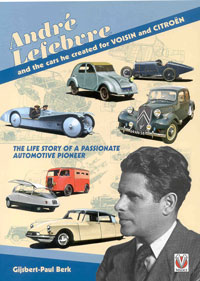
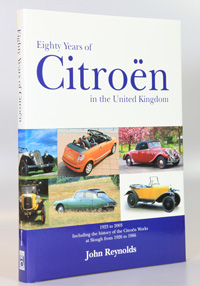 “André Lefebvre” by Gijsbert-Paul Berk. The English version out of stock, but can be ordered as an ebook.
“André Lefebvre” by Gijsbert-Paul Berk. The English version out of stock, but can be ordered as an ebook.
“Eighty Years of Citroën in the United Kingdom” John Reynolds, Dalton Watson 2003 $70
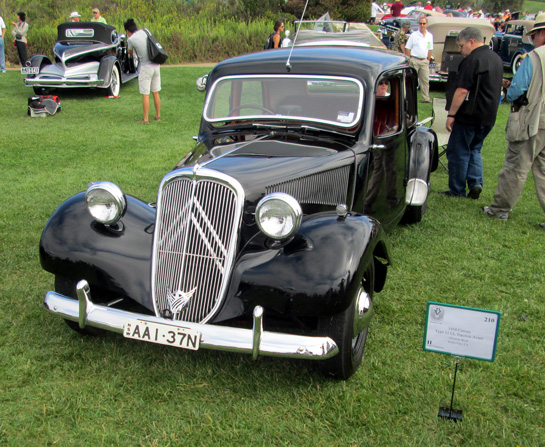
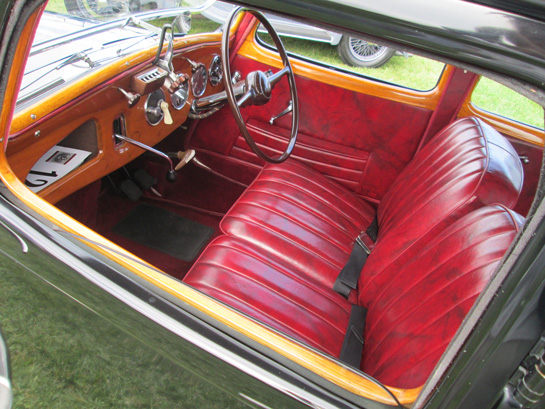
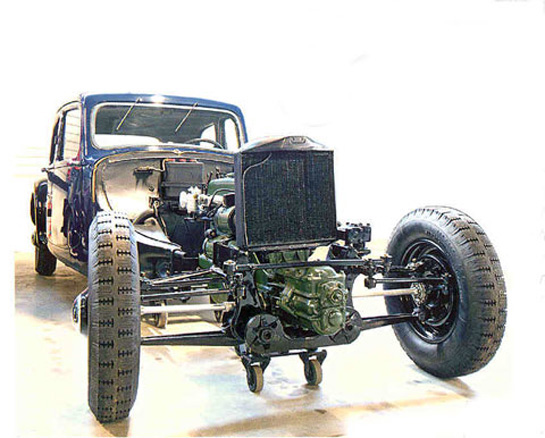

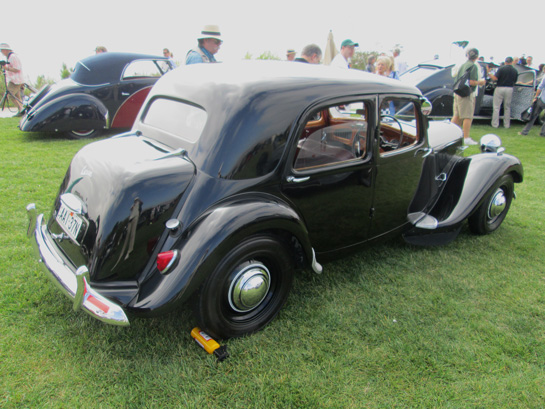
The luxurious interior is due to this TA was build in Britain. French build TAs were more mundane inside with cloth seat covers, metal dashboard and less instrumentation. I don’t know about other British TA versions, but in France a short body version was offered as TA 7 (1300 cc) and TA 9 Berline (1600) and TA 11 Sport (short) and Berline (long) (1900),nd finally the TA 15 CV (6 cyl. 2500 cc) as a limosine.
There was also special Coupe and Convertible versions and a number of commercial variants.
See photos of all variants here https://www.google.dk/search?q=citroen+ta&hl=da&client=firefox-a&hs=mjN&tbo=u&rls=org.mozilla:da:official&tbm=isch&source=univ&sa=X&ei=8xAdUcPQO8fHswa5v4HgCg&ved=0CC8QsAQ&biw=1024&bih=596
Erik
Great story, sorry I missed the PV concours and the Traction. I grew up on the Palos Verdes Penninsula and my first car was a Citroen Traction (11cv, short body). In fact, I was the only person at Rolling Hills High School (class of 68) with a Traction! I bought the car when I was 17 and the previous owner had installed a floor safe (the kind usually cast in a concrete slab) under the front passenger cushion…I believe he used it to keep his grass and some gold leaf safe. Another thing that made my car special, the previous owner had installed a DS 19 engine with weber carb and the appropriate 4 speed transmission. This made the car a real goer and I used it to travel back and forth to Southern Oregon College in Ashland, OR. The only problem with the conversion was that the car still had the original front axles, which meant that it had outboard u-joints, not CV joints. As a result, I had to rebuild the axles every 12 months. When I purchased the car it was black (arn’t they all?) but in my senior year of high school, I painted it dark green with the area below the side windows a lighter, fern green. Wow was that car sharp.
To this day, I wonder what happened to that car? If anyone knows its whereabouts, please contact me at 253 906 9800. Thanks
Thanks for finally talking about >A Citroën Right Hook <Liked it!